Model Predictive Control with Binary Quadratic Programming for the Scheduled Operation of Domestic Refrigerators
Abstract
:1. Introduction
2. Real-Time Identification of Refrigerator Dynamics
3. Experimental System Identification
4. Load Levelling by the Scheduled Operation of Multi-Refrigerator Systems
5. Experimental Results
- Refrigerators operate in isolation without any scheduling controller. This aligns with the normal operating conditions of domestic refrigerators and provides a comparative benchmark.
- is limited to 110 W: the maximum aggregated power for all refrigerators is constrained and all refrigerators are given equal supply priority weightings.
- is limited to 60 W and all refrigerators are given equal supply priority weightings.
- is limited to 60 W and the refrigerators are given unequal supply priority weightings.
5.1. Experimental Setup
5.2. Trial A: Refrigerators Operate in Isolation without A Scheduling MPC Controller
5.3. Trial B: MPC Scheduling with and Equal Supply Priority Is Given to All Refrigerators
5.4. Trial C: MPC Scheduling with and Equal Supply Priority Given to All Refrigerators
5.5. Trial D: MPC Scheduling with and Power Preferentially Delivered to the VonShef Unit
5.6. Comparison of Energy Consumption
6. Domestic Refrigerators and Demand Side Response (DSR)
7. Impact of Hysteresis Band and Internal Thermal Mass on Refrigerator Operational Efficiency
8. Conclusions
Author Contributions
Funding
Conflicts of Interest
Nomenclature
| Symbols | |
| A | System matrix |
| a | Thermal characteristics of refrigerator inner temperature parameter |
| Ac | Overall thermal insulation (W/°C) |
| B | Input matrix |
| b | Impact of the energy transfer from the compressor due to the operation of the system parameter |
| C | Output matrix |
| c | Impact of ambient temperature parameter |
| i | Refrigerators identifier |
| J | Binary Quadratic cost function |
| K(t) | Kalman gain at time t |
| mc | Thermal mass (J/°C) |
| minoff | Minimum off-time per cycle for each refrigerator |
| minon | Minimum on-time per cycle for each refrigerator |
| N1 | Minimum prediction horizons |
| N2 | Maximum prediction horizons |
| Nu | Control horizon |
| n | Number of outputs |
| P(t) | Electrical power required at time t (W) |
| Maximum power consumption at a given time (W) | |
| Q | Weighting factor for control increments |
| R | Weighting factors for predicted error |
| r | Number of inputs |
| s(t) | state of device at time t (a binary ON (1) /OFF (0)) |
| ST | Sample time |
| T(t) | Estimated internal temperature of the refrigerator at the time t (°C) |
| Tamb (t) | Ambient temperature at time t (°C) |
| Tfinish | Experimental test length (Sec) |
| Internal temperature references for each refrigerator which should be kept within upper and lower bounds (°C) | |
| u(t) | Input vector |
| x | State vector |
| ɳ | Coefficient of performance |
| Set of indices in the scheduling horizon | |
| Regression vector at time t | |
| Parameters vector at time t | |
| Abbreviations | |
| BQP | Binary Quadratic Programming |
| DSM | Demand Side Management |
| DSR | Demand Side Response |
| FFR | Firm Frequency Response |
| HVAC | Heating, ventilation, and air conditioning |
| IoT | Internet of Things |
| MPC | Model Predictive Control |
| RLS | Recursive Least Squares |
| TCL | Thermostatically Controlled Load |
Appendix A
| Algorithm 1. Model predictive control (MPC) with binary quadratic programming (BQP) for the scheduled operation of domestic refrigerators |
| 1: Input: |
| 2: N1, N2, Nu and ST For each appliance i: |
| 3: |
| 4: Minoff(i) Minon(i) |
| 5: Q(i) R(i) |
| 6: |
| 7: for t = 0: ST: Tfinish |
| 8: Receive the measured Ti(t), Pi(t) and Tamb(t) from ThingSpeak Calculate the A, B and C matrices using (3)–(10) |
| 9: Receive from ThingSpeak |
| 10: Minimize J considering the constraints (12)–(14) and calculate , using opti and solve commands in MATLAB |
| 11: Send to ThingSpeak |
| end |
| iGENIX | VonShef | Russell Hobbs | |
|---|---|---|---|
| Model | IG 3920 | 13/291 | RHCLRF17B |
| Type | Compressor | Compressor | Thermoelectric |
| Energy rating | A+ | A+ | A+ |
| Total storage capacity (L) | 90 | 47 | 17 |
| Power (W) | 55 | 50 | 50 |
| Voltage (V) | 220–240 | 220–240 | 220–240 |
| Frequency (Hz) | 50 | 50 | 50 |

References
- Department for Business, Energy and Industrial Strategy. UK Energy Statistics, 2018 & Q4 2018; HM Government: London, UK, 2018. Available online: https://assets.publishing.service.gov.uk/government/uploads/system/uploads/attachment_data/file/791297/Press_Notice_March_2019.pdf (accessed on 25 October 2019).
- Department for Business, Energy and Industrial Strategy. Energy Consumption in the UK 1970 to 2018; HM Government: London, UK, 2018. Available online: https://assets.publishing.service.gov.uk/government/uploads/system/uploads/attachment_data/file/820843/Energy_Consumption_in_the_UK__ECUK__MASTER_COPY.pdf (accessed on 25 October 2019).
- Leading Fridge & Fridge/Freezer Brands in the UK. 2018. Available online: https://www.statista.com/statistics/437582/leading-brands-of-fridges-and-fridge-freezers-in-the-uk/ (accessed on 20 October 2019).
- Barther, C.; Götz, T. The Overall Worldwide Saving Potential from Domestic Refrigerators and Freezers; Wuppertal Institute for Climate, Environment and Energy: Wuppertal, Germany, 2012. [Google Scholar]
- International Energy Agency. Key World Energy Statistics 2019; OECD: Paris, France, 2019; ISBN 9789264847880. [Google Scholar]
- Schweppe, F.; Tabors, R.; Kirtley, J.; Outhred, H.; Pickel, F.; Cox, A. Homeostatic Utility Control. IEEE Trans. Power Appar. Syst. 1980, PAS-99, 1151–1163. [Google Scholar] [CrossRef]
- Malhame, R.; Chong, C.-Y. Electric load model synthesis by diffusion approximation of a high-order hybrid-state stochastic system. IEEE Trans. Autom. Contr. 1985, 30, 854–860. [Google Scholar] [CrossRef]
- Stadler, M.; Krause, W.; Sonnenschein, M.; Vogel, U. Modelling and evaluation of control schemes for enhancing load shift of electricity demand for cooling devices. Environ. Model. Softw. 2009, 24, 285–295. [Google Scholar] [CrossRef]
- Angeli, D.; Kountouriotis, P.-A. A Stochastic Approach to “Dynamic-Demand” Refrigerator Control. IEEE Trans. Control Syst. Technol. 2012, 20, 581–592. [Google Scholar] [CrossRef]
- Borsche, T.S.; de Santiago, J.; Andersson, G. Stochastic control of cooling appliances under disturbances for primary frequency reserves. Sustain. Energy Grids Netw. 2016, 7, 70–79. [Google Scholar] [CrossRef]
- Aunedi, M.; Kountouriotis, P.-A.; Calderon, J.E.O.; Angeli, D.; Strbac, G. Economic and Environmental Benefits of Dynamic Demand in Providing Frequency Regulation. IEEE Trans. Smart Grid 2013, 4, 2036–2048. [Google Scholar] [CrossRef]
- Tindemans, S.H.; Trovato, V.; Strbac, G. Decentralized Control of Thermostatic Loads for Flexible Demand Response. IEEE Trans. Control Syst. Technol. 2015, 23, 1685–1700. [Google Scholar] [CrossRef]
- Saleh, I.; Postnikov, A.; Arsene, C.; Zolotas, A.; Bingham, C.; Bickerton, R.; Pearson, S. Impact of Demand Side Response on a Commercial Retail Refrigeration System. Energies 2018, 11, 371. [Google Scholar] [CrossRef] [Green Version]
- Niro, G.; Salles, D.; Alcântara, M.V.P.; da Silva, L.C.P. Large-scale control of domestic refrigerators for demand peak reduction in distribution systems. Electr. Power Syst. Res. 2013, 100, 34–42. [Google Scholar] [CrossRef]
- Belman-Flores, J.M.; Ledesma, S.; Rodríguez-Valderrama, D.A.; Hernández-Fusilier, D. Energy optimization of a domestic refrigerator controlled by a fuzzy logic system using the status of the door. Int. J. Refrig. 2019, 104, 1–8. [Google Scholar] [CrossRef]
- Serale, G.; Fiorentini, M.; Capozzoli, A.; Bernardini, D.; Bemporad, A. Model Predictive Control (MPC) for Enhancing Building and HVAC System Energy Efficiency: Problem Formulation, Applications and Opportunities. Energies 2018, 11, 631. [Google Scholar] [CrossRef] [Green Version]
- Carrascal, E.; Garrido, I.; Garrido, A.; Sala, J. Optimization of the Heating System Use in Aged Public Buildings via Model Predictive Control. Energies 2016, 9, 251. [Google Scholar] [CrossRef]
- Baghina, N.; Lampropoulos, I.; Asare-Bediako, B.; Kling, W.L.; Ribeiro, P.F. Predictive control of a domestic freezer for real-time demand response applications. In Proceedings of the 2012 3rd IEEE PES Innovative Smart Grid Technologies Europe (ISGT Europe), Berlin, Germany, 14–17 October 2012; pp. 1–8. [Google Scholar] [CrossRef]
- Sossan, F.; Lakshmanan, V.; Costanzo, G.T.; Marinelli, M.; Douglass, P.J.; Bindner, H. Grey-box modelling of a household refrigeration unit using time series data in application to demand side management. Sustain. Energy Grids Netw. 2016, 5, 1–12. [Google Scholar] [CrossRef] [Green Version]
- Schné, T.; Jaskó, S.; Simon, G. Embeddable adaptive model predictive refrigerator control for cost-efficient and sustainable operation. J. Clean. Prod. 2018, 190, 496–507. [Google Scholar] [CrossRef]
- Constantopoulos, P.; Schweppe, F.C.; Larson, R.C. Estia: A real-time consumer control scheme for space conditioning usage under spot electricity pricing. Comput. Oper. Res. 1991, 18, 751–765. [Google Scholar] [CrossRef] [Green Version]
- Shirazi, E.; Zakariazadeh, A.; Jadid, S. Optimal joint scheduling of electrical and thermal appliances in a smart home environment. Energy Convers. Manag. 2015, 106, 181–193. [Google Scholar] [CrossRef]
- Bozchalui, M.C.; Hashmi, S.A.; Hassen, H.; Canizares, C.A.; Bhattacharya, K. Optimal Operation of Residential Energy Hubs in Smart Grids. IEEE Trans. Smart Grid 2012, 3, 1755–1766. [Google Scholar] [CrossRef]
- Kumar, K.N.; Vijayakumar, K.; Kalpesh, C. Virtual energy storage capacity estimation using ANN-based kWh modelling of refrigerators. IET Smart Grid 2018, 1, 31–39. [Google Scholar] [CrossRef]
- Ljung, L. System Identification: Theory for the User, 2nd ed.; Prentice Hall Information and System Sciences Series; Prentice Hall PTR: Upper Saddle River, NJ, USA, 1999; ISBN 9780136566953. [Google Scholar]
- Camacho, E.F.; Bordons, C. Model Predictive Control; Advanced Textbooks in Control and Signal Processing; Springer: London, UK; New York, NY, USA, 2004; ISBN 9781852336943. [Google Scholar]
- Achterberg, T. SCIP: Solving constraint integer programs. Math. Prog. Comp. 2009, 1, 1–41. [Google Scholar] [CrossRef]
- Geppert, J.; Stamminger, R. Analysis of effecting factors on domestic refrigerators’ energy consumption in use. Energy Convers. Manag. 2013, 76, 794–800. [Google Scholar] [CrossRef]
- Harrington, L.; Aye, L.; Fuller, B. Impact of room temperature on energy consumption of household refrigerators: Lessons from analysis of field and laboratory data. Appl. Energy 2018, 211, 346–357. [Google Scholar] [CrossRef]
- Söylemez, E.; Alpman, E.; Onat, A. Experimental analysis of hybrid household refrigerators including thermoelectric and vapour compression cooling systems. Int. J. Refrig. 2018, 95, 93–107. [Google Scholar] [CrossRef]
- Zavvar Sabegh, M.R.; Bingham, C.M. Impact of Hysteresis Control and Internal Thermal Mass on the Energy Efficiency of IoT-Controlled Domestic Refrigerators. In Proceedings of the 2019 IEEE 7th International Conference on Smart Energy Grid Engineering (SEGE), Oshawa, ON, Canada, 12–14 August 2019; pp. 103–107. [Google Scholar] [CrossRef]
- Postnikov, A.; Albayati, I.M.; Pearson, S.; Bingham, C.; Bickerton, R.; Zolotas, A. Facilitating static firm frequency response with aggregated networks of commercial food refrigeration systems. Appl. Energy 2019, 251, 113357. [Google Scholar] [CrossRef]
- HOME—ICEAGE REFRIGERATION. Available online: http://www.iceage-hvac.com/Uploads/Product/2014-12-22/5497c67a7dc35.pdf (accessed on 25 October 2019).
- BITZER//us. Available online: https://www.bitzer.de/shared_media/documentation/kt-100-3.pdf (accessed on 25 October 2019).
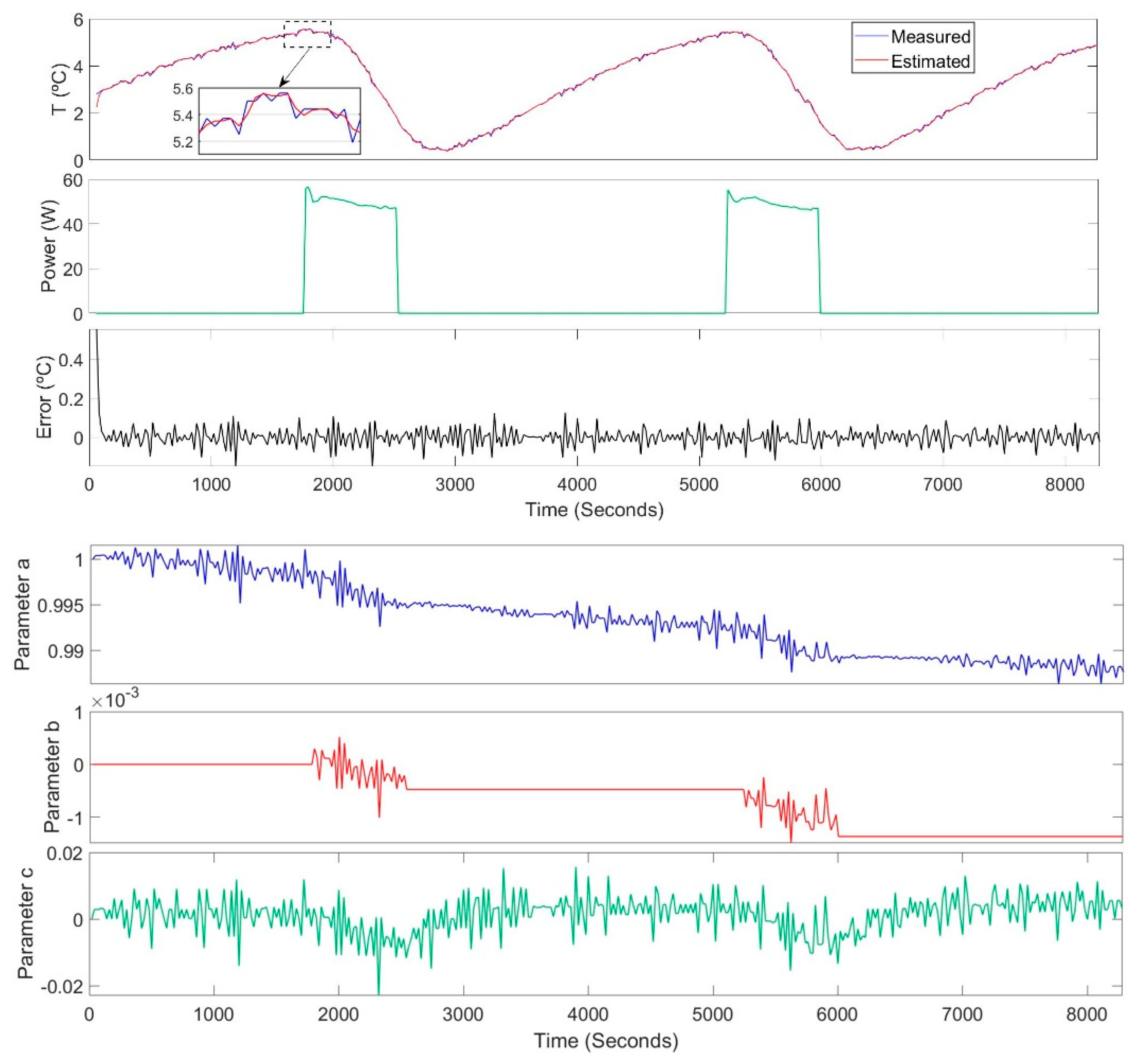
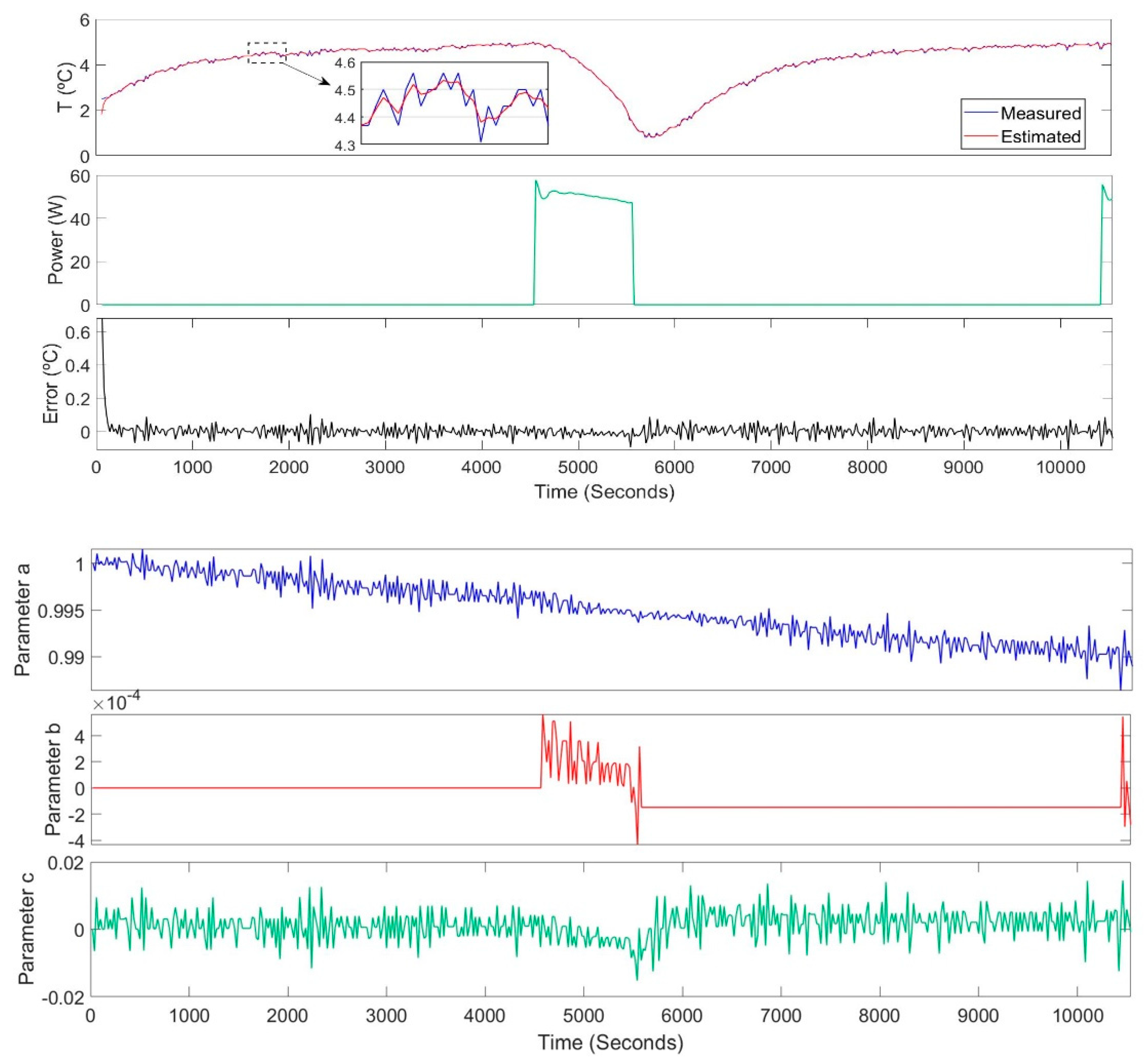
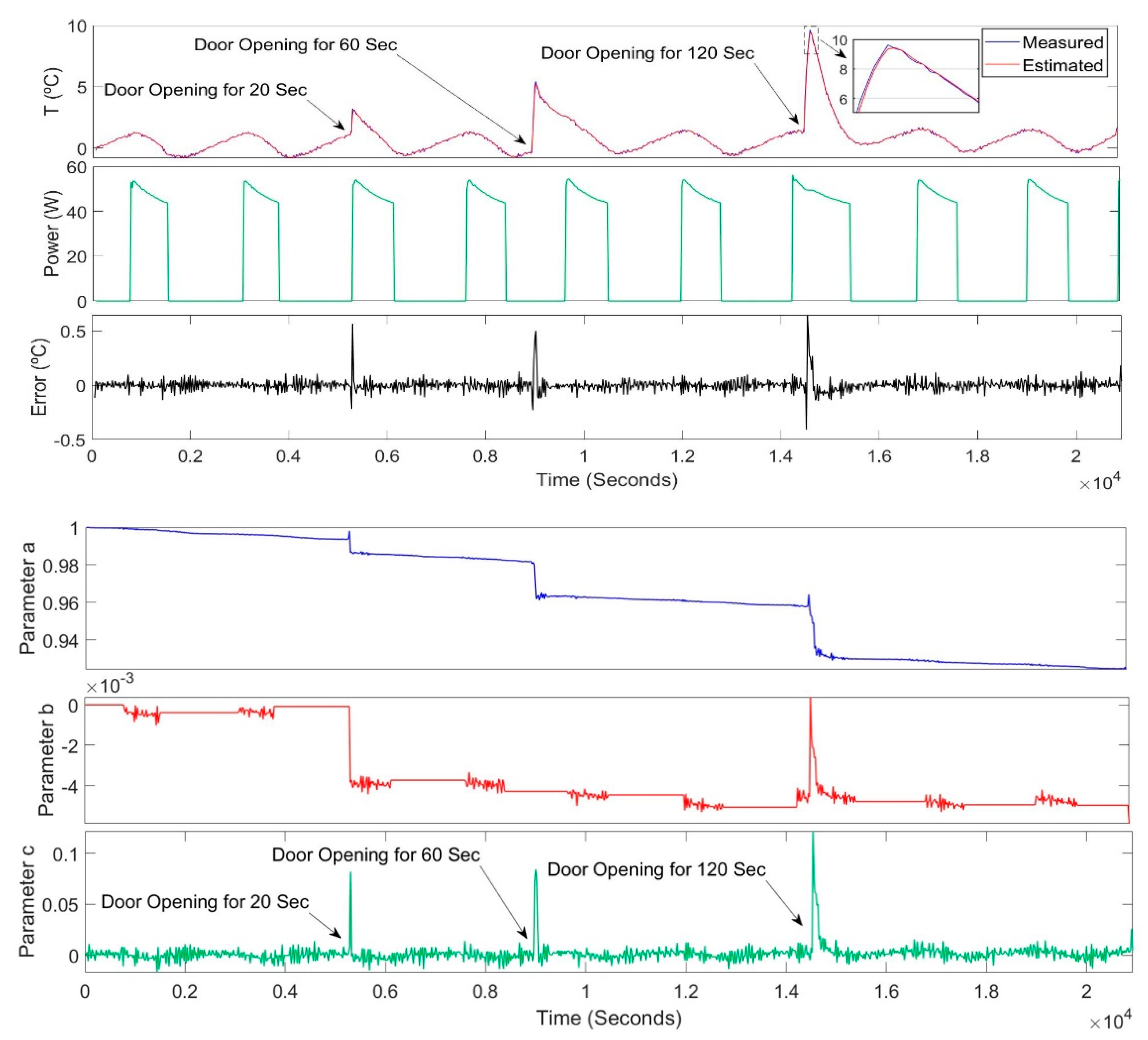

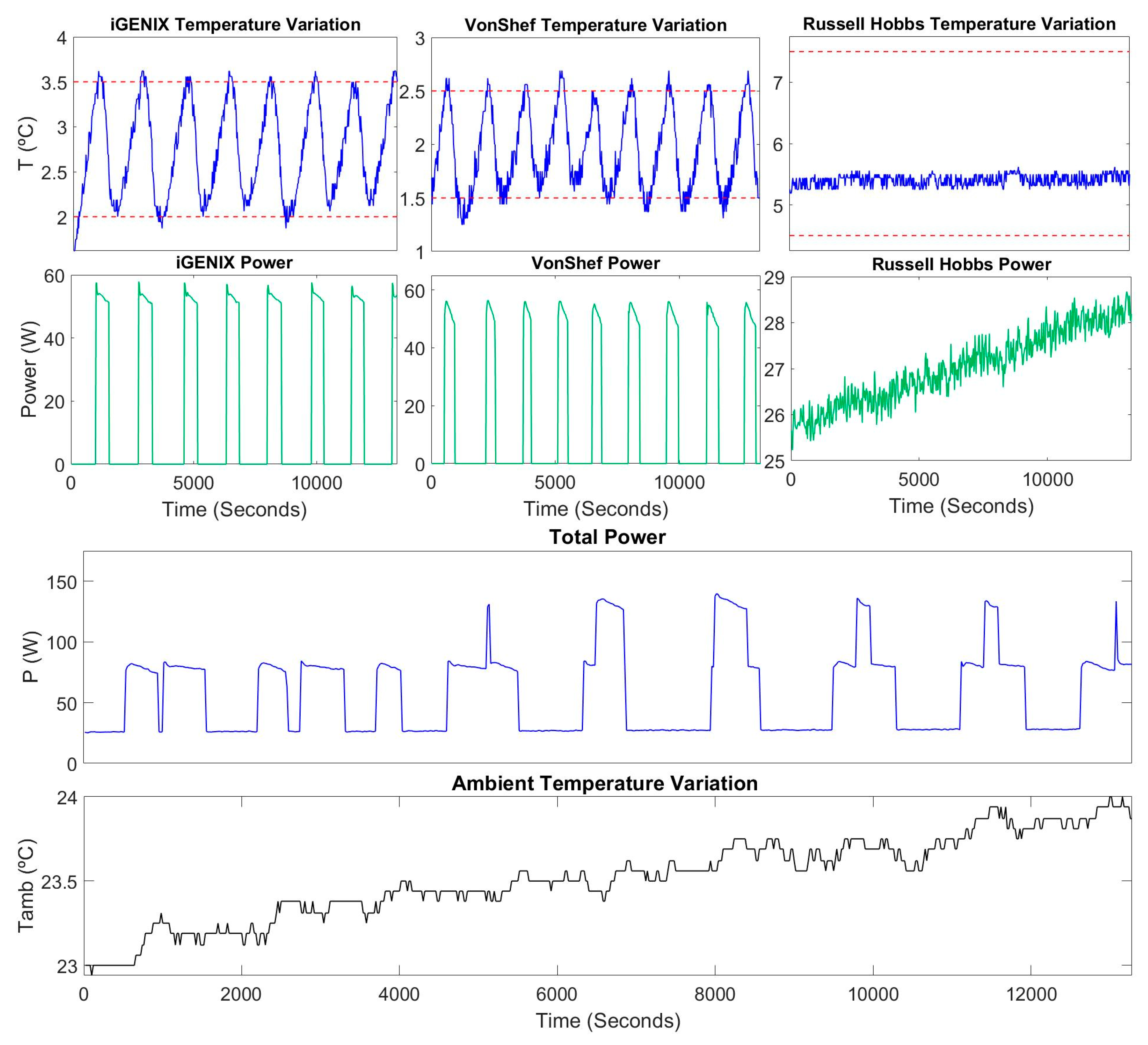

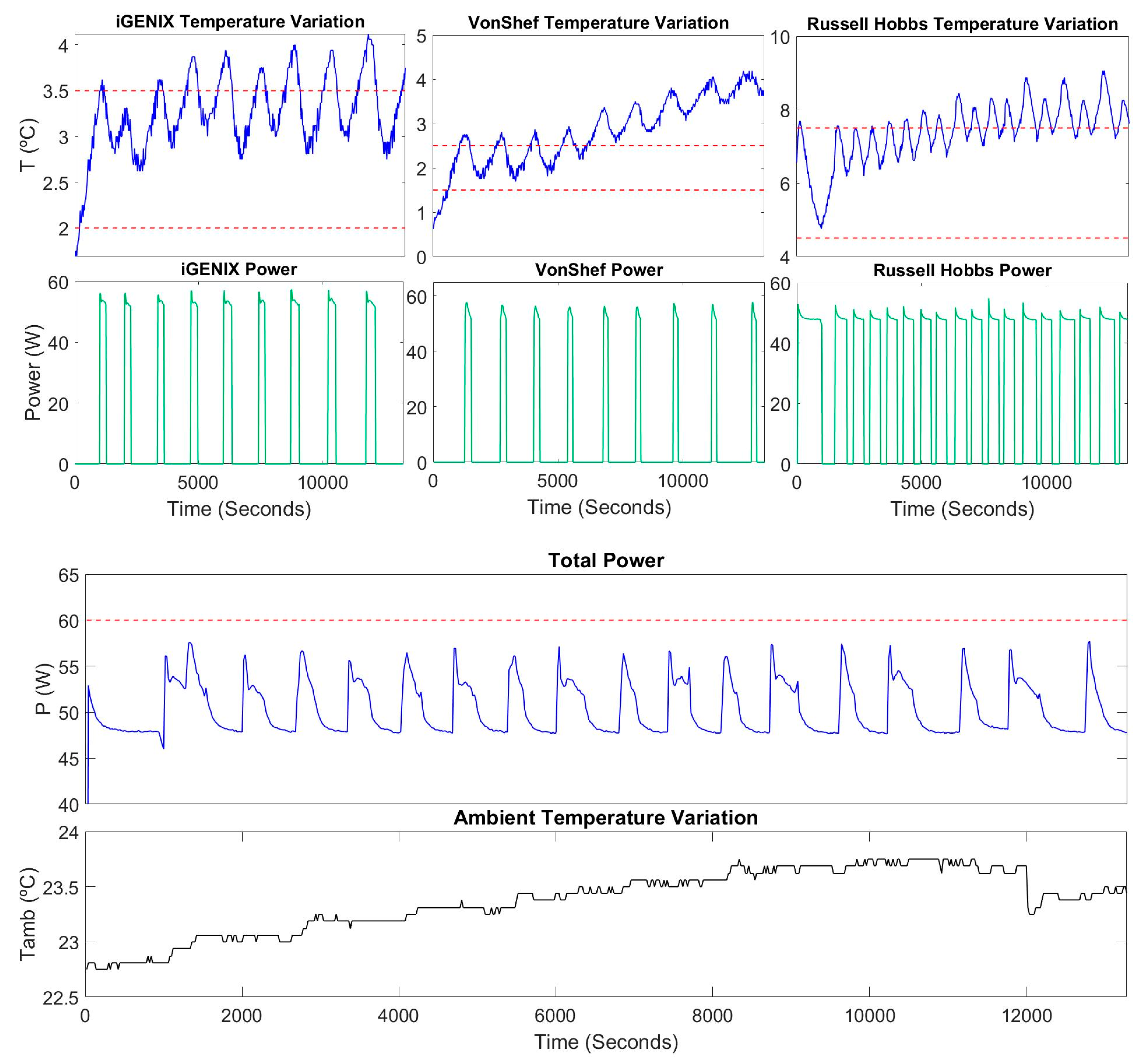
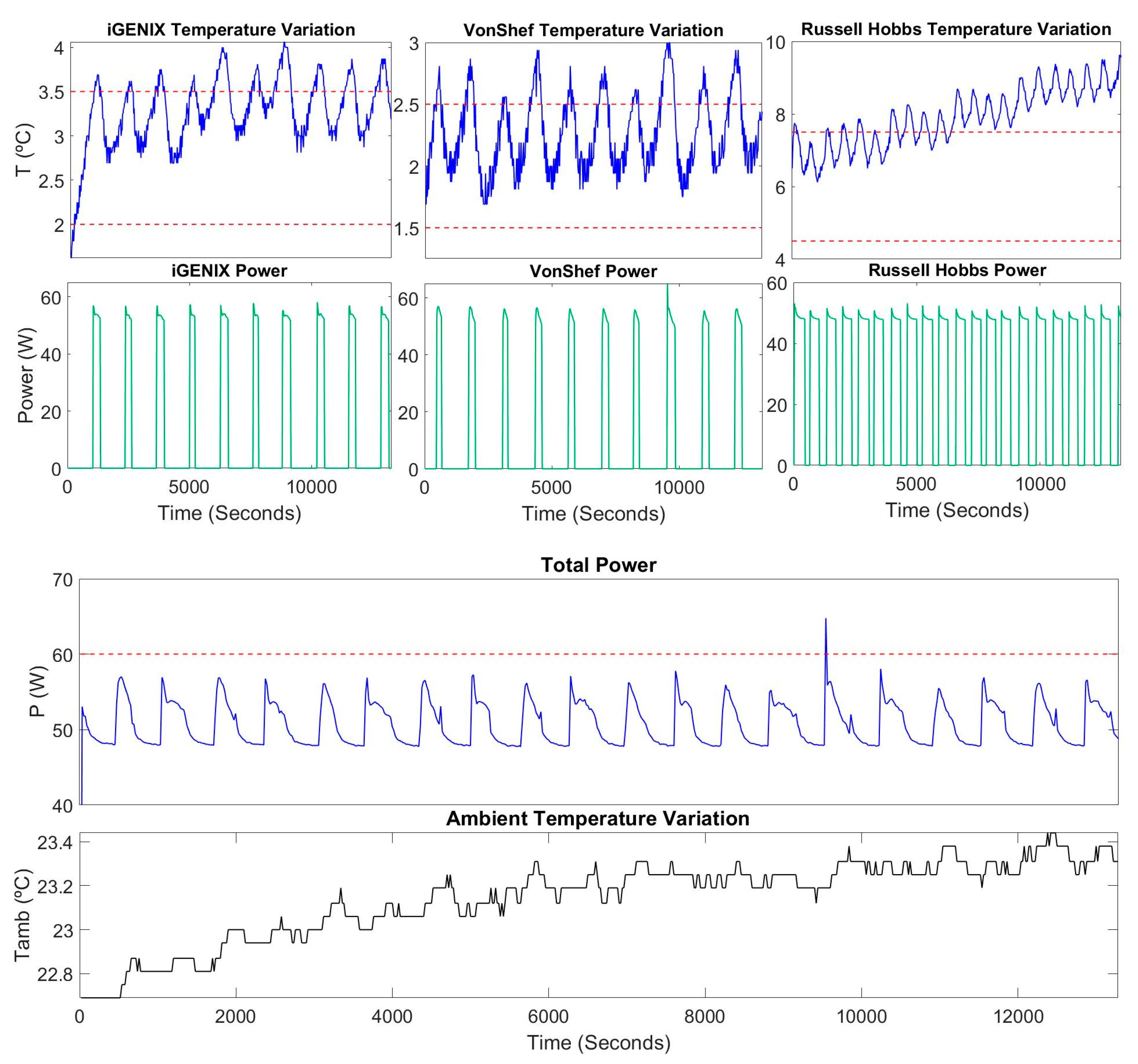
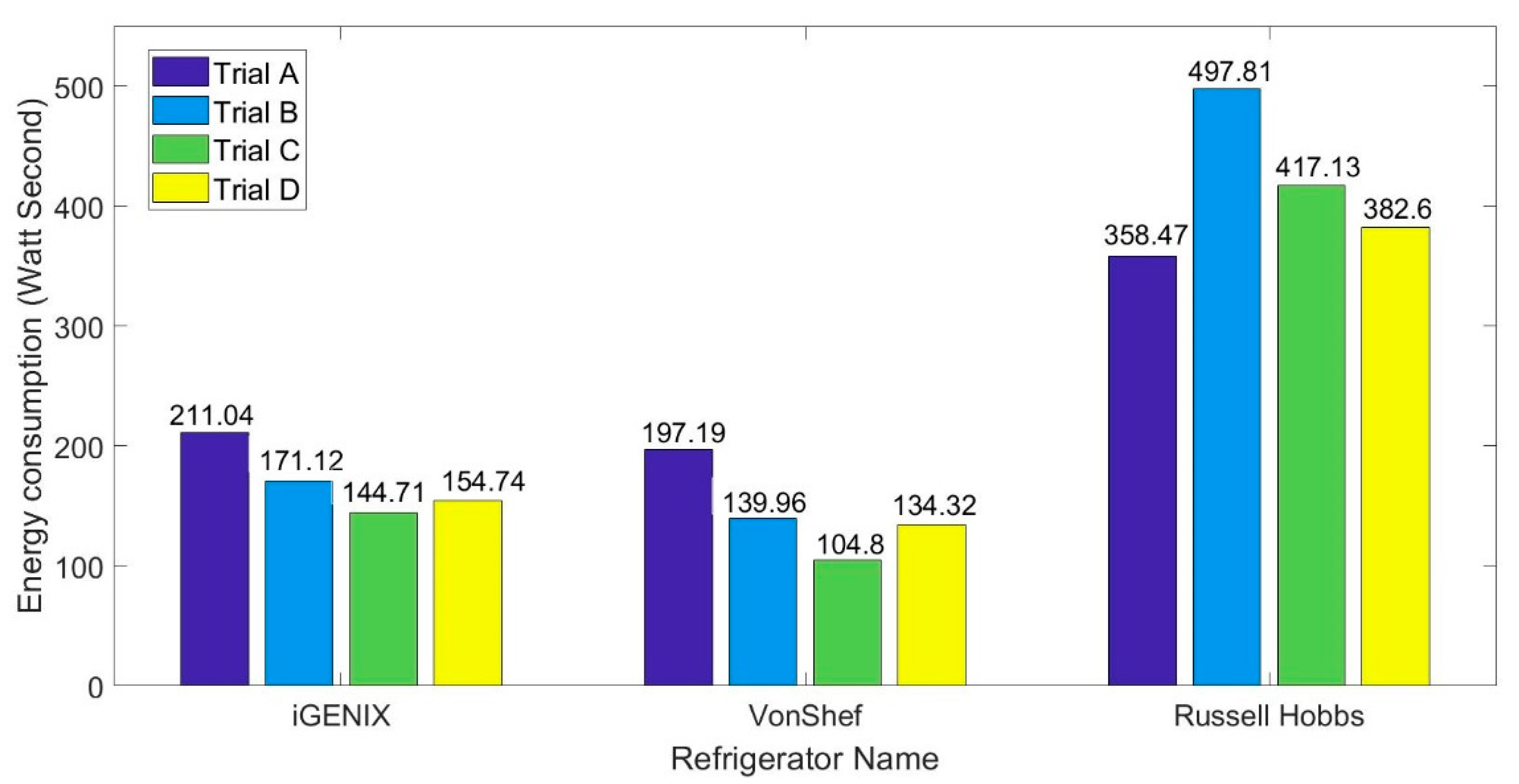
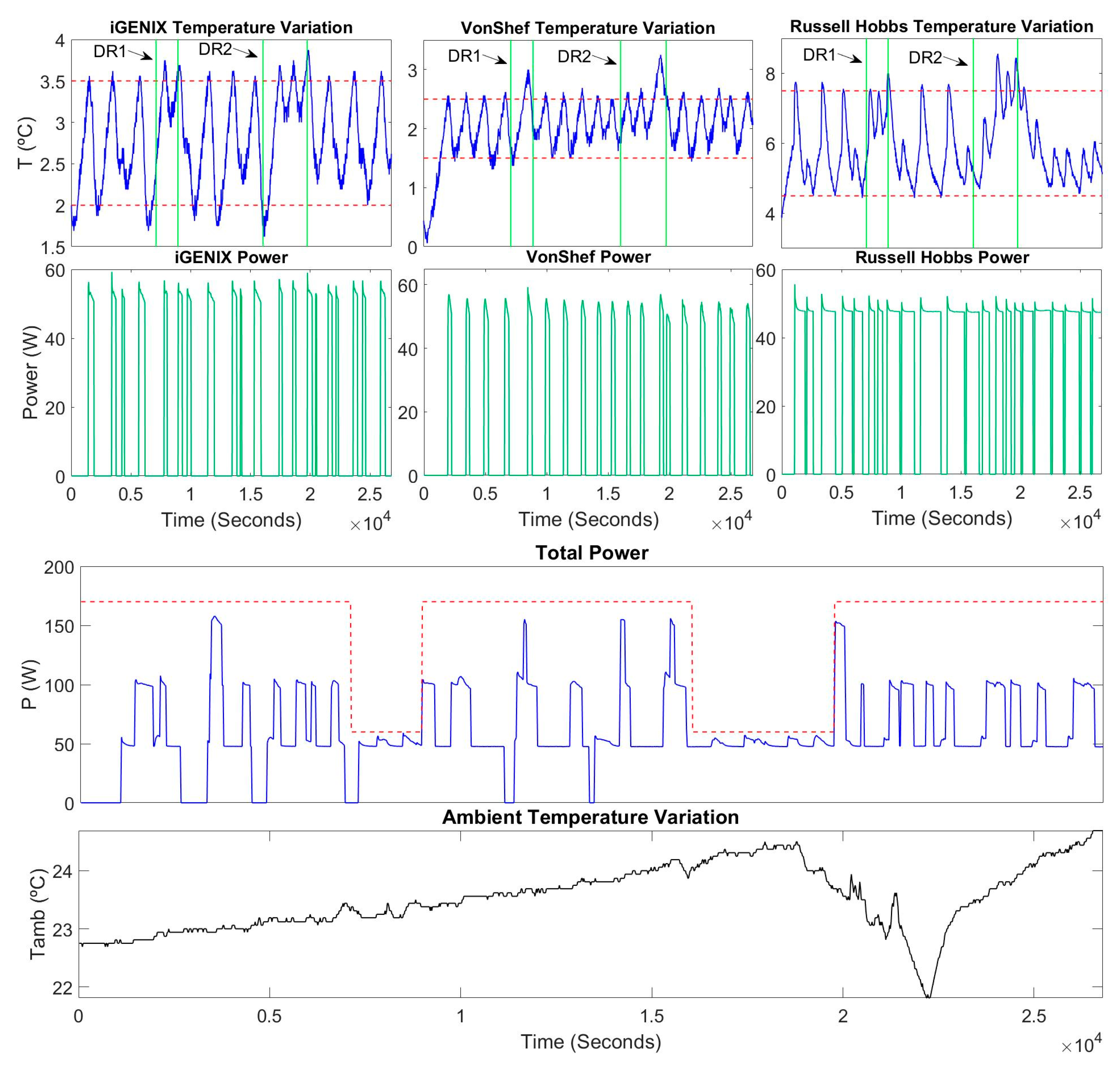
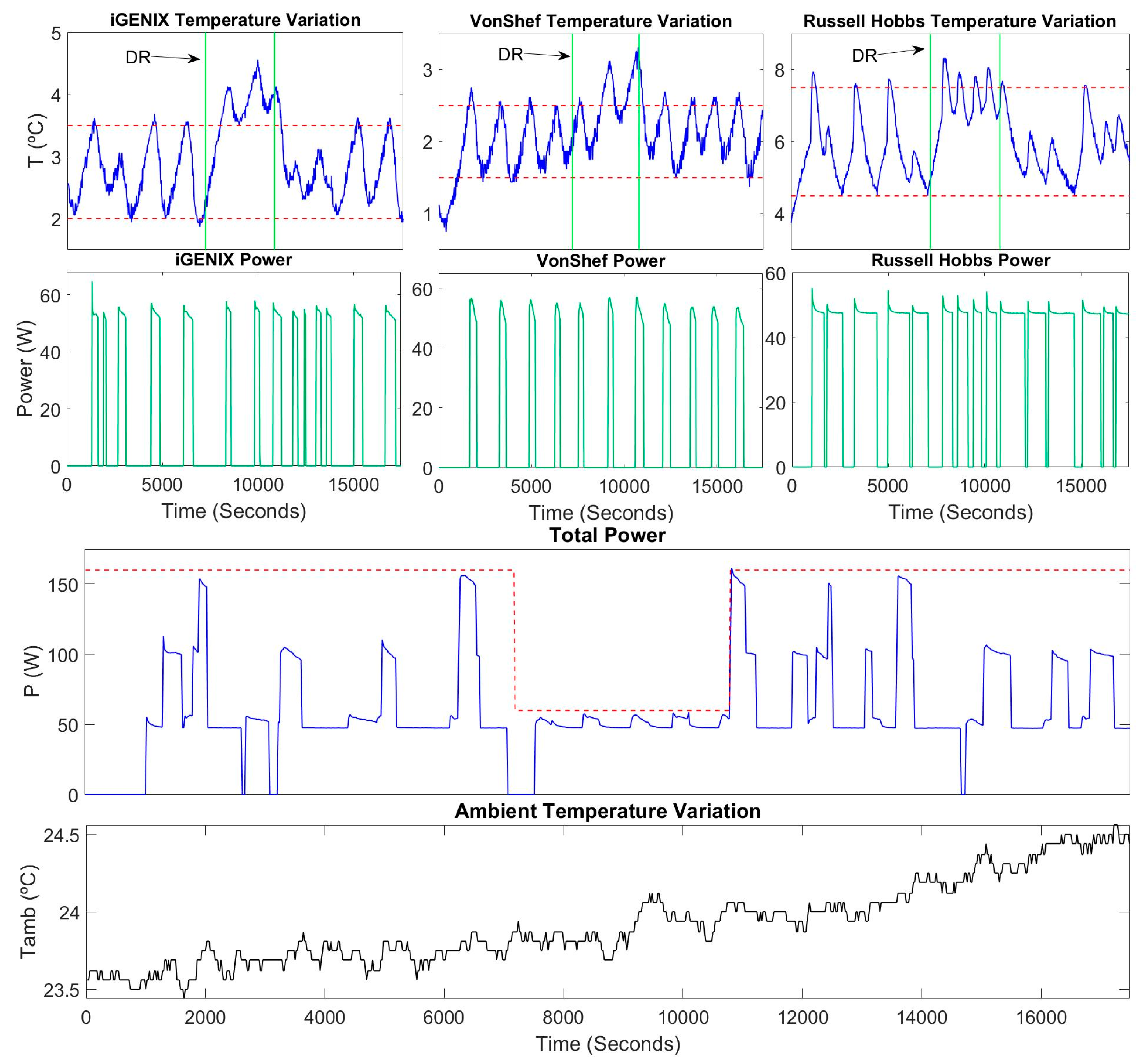
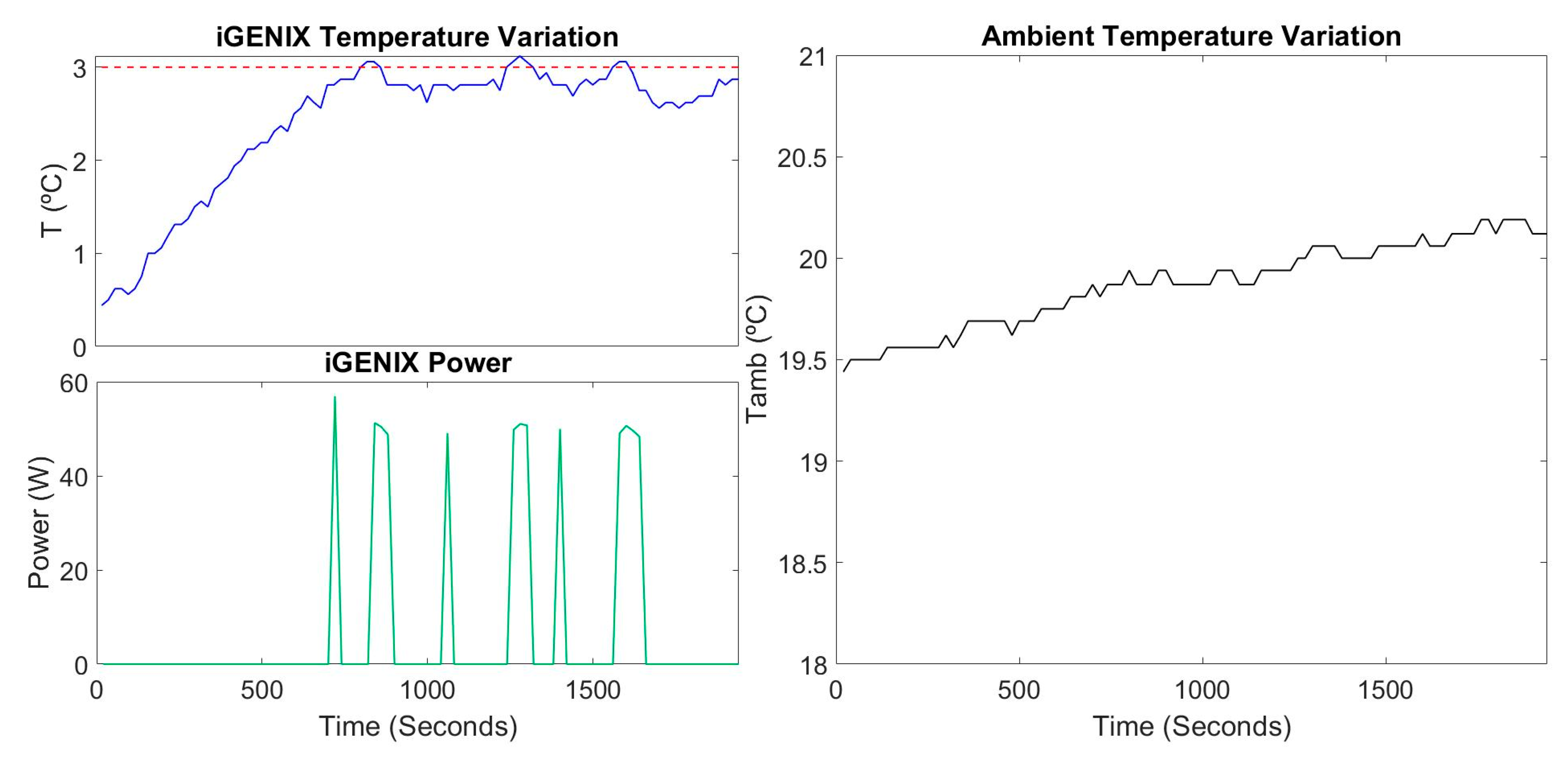


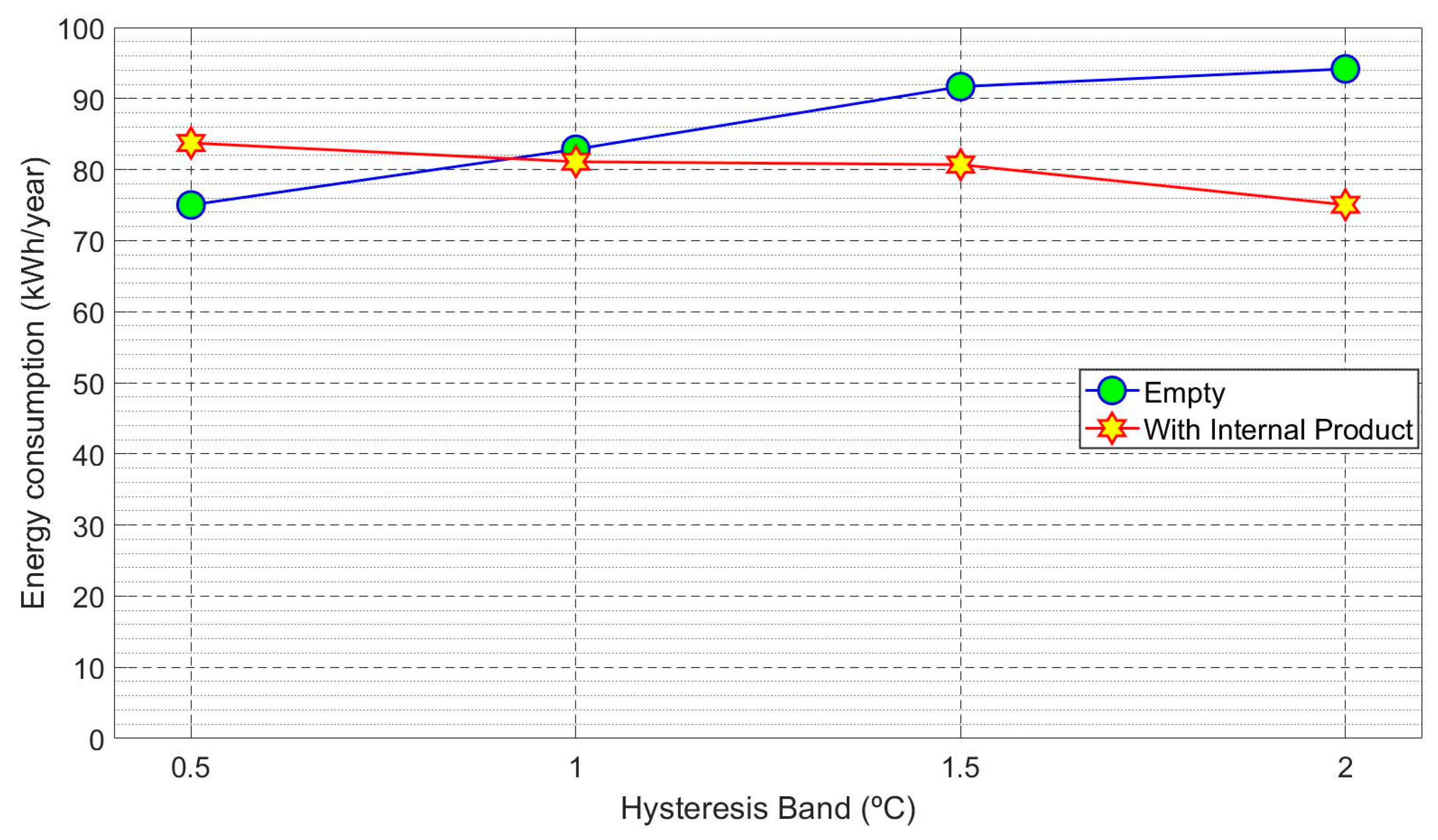
| Name | Upper Band (°C) | Lower Band (°C) | Minimum on Time (s) | Minimum off Time (s) |
|---|---|---|---|---|
| iGENIX | 3.5 | 2 | 220 | 240 |
| VonShef | 2.5 | 1.5 | 260 | 200 |
| Russell Hobbs | 7.5 | 4.5 | 380 | 100 |
© 2019 by the authors. Licensee MDPI, Basel, Switzerland. This article is an open access article distributed under the terms and conditions of the Creative Commons Attribution (CC BY) license (http://creativecommons.org/licenses/by/4.0/).
Share and Cite
Zavvar Sabegh, M.R.; Bingham, C. Model Predictive Control with Binary Quadratic Programming for the Scheduled Operation of Domestic Refrigerators. Energies 2019, 12, 4649. https://doi.org/10.3390/en12244649
Zavvar Sabegh MR, Bingham C. Model Predictive Control with Binary Quadratic Programming for the Scheduled Operation of Domestic Refrigerators. Energies. 2019; 12(24):4649. https://doi.org/10.3390/en12244649
Chicago/Turabian StyleZavvar Sabegh, Mohammad Reza, and Chris Bingham. 2019. "Model Predictive Control with Binary Quadratic Programming for the Scheduled Operation of Domestic Refrigerators" Energies 12, no. 24: 4649. https://doi.org/10.3390/en12244649
APA StyleZavvar Sabegh, M. R., & Bingham, C. (2019). Model Predictive Control with Binary Quadratic Programming for the Scheduled Operation of Domestic Refrigerators. Energies, 12(24), 4649. https://doi.org/10.3390/en12244649






